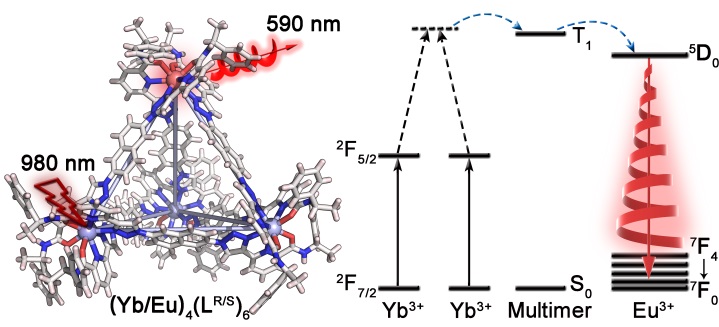Integrating circularly polarized luminescence with upconversion has garnered considerable attention. Upconverted circularly polarized luminescence (UCCPL) represents a novel anti-Stokes-like chiropticalbehavior that converts unpolarized low-energy photons into high-energy ones with circular polarization. To date, this optical phenomenon has been achieved in triplet−triplet annihilation upconversion, two-photon absorption, and upconversion nanoparticles.
Molecular UC of lanthanide complexes, with controllable syntheses, precise architectures, and favorable solubility, has similarly been particularly compelling in recent years. However, achieving UCCPL in a lanthanide supramolecular system remains highly challenging, hindered by weak upconversion luminescence and uncontrollable stereochemistry.
In a study published in CCS Chemistry, the research group led by Prof. SUN Qingfu from Fujian Institute of Research on the Structure of Matter of the Chinese Academy of Sciences reported the first example of lanthanide supramolecular UCCPL in solution.
Researchers constructed tetrahedral Ln4(LR/S)6 cages with ΔΔΔΔ or ΛΛΛΛ metal stereochemistry by assembling C2-symmetric chiral ligands LR/S with Ln3+ ions. Nuclear magnetic resonance, electrospray ionization time-of-flight mass spectrometry, X-ray crystallography, circular dichroism spectroscopy, and circularly polarized luminescence spectroscopy jointly confirmed the formation of enantiopure Ln4(LR/S)6 (Ln = Eu, Sm, Gd, Yb).
Downshifting spectra and Hirshfeld surface analysis revealed supramolecular assembly effectively constrains interligand orientations, distances, and vibrations. Consequently, the phosphorescence of Ln4(LR/S)6 originates from the collective contribution of the multimer formed by intramolecular ligand-ligand coupling.
Remarkably, the lowest excited triplet state T1 at 493 nm (energy level approximately 20300 cm-1) for the ligand’s multimer precisely matches not only the excited energy levels of typical Ln3+ ions (e.g., Eu3+, Sm3+) for downshifting luminescence but also the quasi-virtual energy level accessible by two Yb3+ ions for UC luminescence.
Under 980 nm excitation, upconversion emissions from Eu3+ and Sm3+ centers in the heterometallic (Yb/Eu)4(LR/S)6 and (Yb/Sm)4(LR/S)6 assemblies were realized via multimeric triplet-mediated long distance (1.67 nm) cooperative sensitization pathways in solution at room temperature.
Most importantly, by integrating photon UC with chirality, we achieved UCCPL of Eu3+ (glum = 10-2) in rare-earth (Yb/Eu)4(LR/S)6 supramolecular system for the first time, exploiting a new territory for chiral rare-earth functional materials.
This study introduces a novel approach to designing UCCPL materials and opens new avenues for the development of chiral rare-earth functional materials.

Illustration of multimer triplet-mediated upconverted circularly polarized luminescence (Image by Prof. SUN’s group)
Contact:
Prof. SUN Qingfu
Fujian Institute of Research on the Structure of Matter
Chinese Academy of Sciences
Email:qfsun@fjirsm.ac.cn